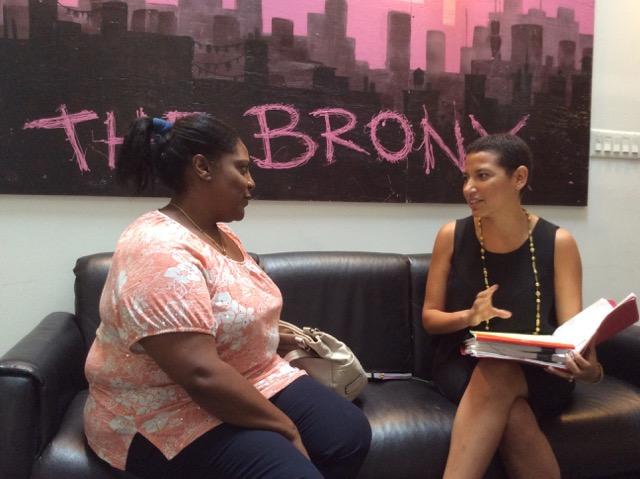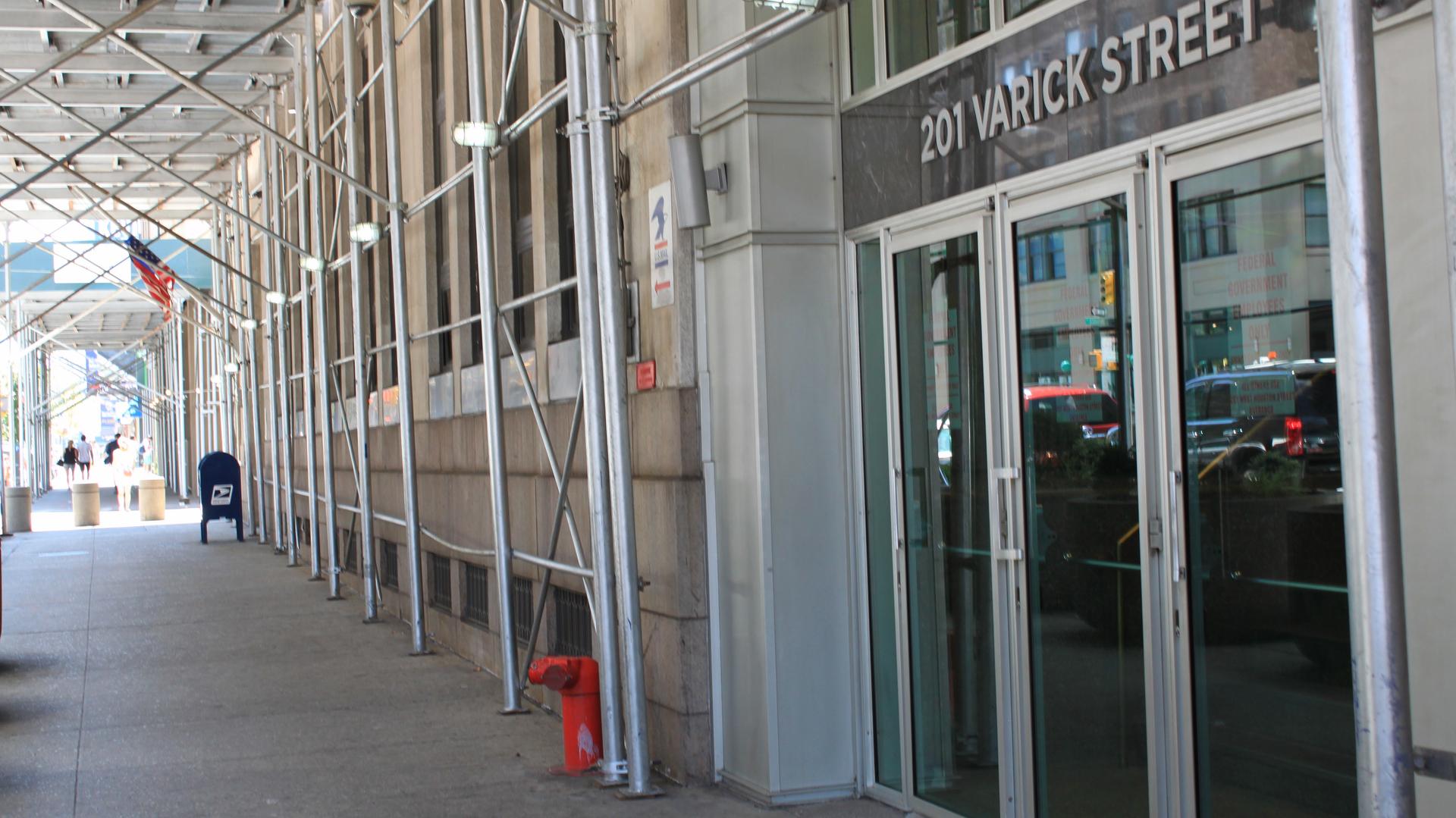In New York City, lawyers make all the difference for immigrant detainees facing deportation
The entrance to the Varick Street Immigration Court in New York City. The city has begun a program to provide pro bono attorneys to every immigrant detainee in proceedings here.
There’s something about our immigration court system that many people don’t realize: Immigrants have no right to counsel. When someone faces a judge, but does not have or cannot afford an attorney, there are no public defenders to pick up the case.
While it's hard enough for the working poor to find qualified representation, doing so as an immigrant in detention is almost impossible. Just 37 percent of people facing deportation have an attorney with them. For people in immigration detention, that number falls to 14 percent, according to a study published in the University of Pennsylvania Law Review. Including people seeking asylum and families with children — a large number of the most vulnerable people face government attorneys and the judge alone.
The New York City program to provide immigrants with attorneys began after this data was studied. These numbers do no reflect the representation it provides.
Also: Without lawyers, 90% of children crossing into the US alone seeking safety could be sent back
But there’s good news coming out of New York City for the thousands of people in immigration court without representation each year.
This year, deportation orders issued at the Varick Street Immigration Court in Manhattan are projected to be at their lowest level since 2013. In 2012, 1,202 people were ordered removed from the US at that courthouse, according to data compiled by the Transactional Records Access Clearinghouse at Syracuse University. This year? Just 535.
The steady decline in deportations is partially credited to a project that’s the first of its kind in the nation. In 2013, the New York Immigrant Family Unit Program began to provide publicly funded, universal representation to poor detainees in removal proceedings. The initiative ensures that anyone in immigration detention whose case is heard at the immigration court on Varick Street has access to a highly qualified immigration attorney.
“No family can have a loved one locked up and deported, simply because they can’t afford counsel,” says Peter Markowitz, director of the Immigration Justice Clinic at Cardozo School of Law. “That’s not justice, and we don’t do that in New York.”
Markowitz, who helped secure funding and shape the program, is proud that the city is setting new standards to provide fair day in court for everyone. He hopes that, eventually, all immigrants facing deportation from the US will have a right to counsel.
For now, Jacqueline De La Rosa, 52, is grateful. A Dominican who has lived in New York since 1986, she’s the primary caretaker for her disabled 20-year-old son, Emmanuel.
More than 20 years ago, the federal government challenged the validity of her marriage to a US citizen by opening a case that, unbeknownst to De La Rosa, she could have challenged in court. But her lawyer at the time told her the case was over. De La Rosa presumed she had become undocumented and there wasn’t anything she could do.
A domestic worker with three American-born sons to support, she went about her life. In 2007, though, she was convicted of a “minor drug possession crime.” Again on the advice of her attorney, she took a plea bargain and served five years probation, not knowing the potential consequences to her immigration status.
Eight years later, on March 13, 2015, Immigration and Customs Enforcement knocked on her door.
“Four officers came to my home at 6 am,” De La Rosa says in Spanish. “They said I have to go with them, but I still don’t know why.”
They told her she was being taken for an interview, but she was instead detained for almost six months and put into deportation proceedings. De La Rosa was first imprisoned in Hudson County, New Jersey, then in Orange County, upstate New York.
With a complicated case and not much money — particularly while she was detained and unable to work — she couldn’t afford an attorney trained in the intricacies of immigration law. The New York City program was designed to give people like her a fair hearing in court.

Ostolaza’s best guess is that De La Rosa’s 2007 conviction might have triggered “priority enforcement” for deportation under federal guidelines.
In detention, De La Rosa says they called her “cry, cry” because she couldn’t stop agonizing over her son, who wears a leg brace and has limited control of his left arm.
“Ay, mi Dios, mi hermana lo ayudó,” she says shaking her head. “Oh, my God, my sister helped him.” But Emmanuel still didn’t have anyone to take him to physical therapy and his health declined. Meanwhile, De La Rosa lost her job and the family’s apartment.
“Those are the people where counsel can make the most dramatic difference,” says Markowitz.
Detained immigrants are at the core of a legal representation emergency that has plagued not only New York, home to one of the largest foreign-born populations in the country, but also the nation after many years of heightened immigration enforcement by federal authorities.
More: Is Obama really the 'Deporter-in-Chief?' Depends on whom you ask
A study in 2010, spearheaded by judge Robert A. Katzmann, now the chief judge of the US Court of Appeals for the Second Circuit, analyzed the problem.
Sixty percent of those in removal proceedings while in immigration custody in New York had no counsel (PDF). They didn’t stand a chance against trained government lawyers in his court, the highest in the region, where litigation is the most complex. As a result, only 3 percent of those who are “unrepresented and detained” won a reprieve from deportation.
Furthermore, nearly 50 percent of the lawyers representing immigrants performed either inadequately or “grossly” inadequately. Being free and having quality counsel emerged as the most crucial deciding factors in a person’s fate. Katzmann’s study found that detained immigrants with attorneys were 500 percent more likely to win their cases than those without.
The New York City program turned the tide. From November 2013 through June 2016, they provided 1,898 people with specialized attorneys, according to the Vera Institute of Justice which oversees data collection on the program. Research published by the National Immigration Law Center in March 2016 (PDF), projects that the program might increase the chances for detained immigrants to win their cases by 1,000 percent. But the data, says Markowitz, is still preliminary.
After its pilot year in 2014, the New York City Council publicly funded the New York Immigrant Family Unit Program. The coalition of nonprofit organizations behind the program says it costs taxpayers less to provide immigrants counsel than keeping them behind bars or deporting them. The New York State Assembly funded the same program at the Buffalo Federal Detention Center in upstate New York.
To ensure that the city would not run short of capable removal defense attorneys, Katzmann, Markowitz and Nisha Agarwal, commissioner of the New York Mayor’s Office of Immigrant Affairs, also collaborated on the creation of the Immigrant Justice Corps, a fellowship that recruits the best law graduates in the US. Ostolaza is one of them.
Luis Mancheno, an Immigrant Justice Corps alum and now a fellow at Markowitz’s legal clinic, was another. He says people are often shocked to learn that if it weren’t for the New York City program, they would not be represented.
An Ecuadorian lawyer who himself was granted asylum in 2009, Mancheno went to law school again in the US to help other immigrants. He’s worked on about 40 cases with the Bronx Defenders.
“If people knew what a person goes through while in proceedings, what their families go through,” he says, “we would have hundreds more lawyers representing them.”
The work done in New York has resonated throughout the country. In New Jersey, the American Friends Service Committee has been running the Friends Representation Initiative of New Jersey, which has served 396 detained individuals. It launched in 2015.
In the Bay Area, the Alameda County Public Defender office started California’s first Public Defender Immigration Representation Project. Unlike its New York and New Jersey counterparts, Alameda only considers cases of either current or former clients in criminal proceedings, who also need immigration assistance.
Across the bay, the San Francisco Immigration Legal Defense Collaborative started in 2015. It offers universal representation to immigrant women and children whose cases have been prioritized by the San Francisco Immigration Court. The majority of these families have escaped violence in Central America.
Having an attorney has made a huge difference for De La Rosa. She remembers the day Ostolaza took her case.
“It was the best day of my life,” she says.
She was released on a $3,000 bond on August 25, 2015. For De La Rosa, the next step will be to focus on trying to confirm her status as a permanent resident, challenged many years ago, and cancel her deportation.
And that starts with having a chance to be represented in court.
